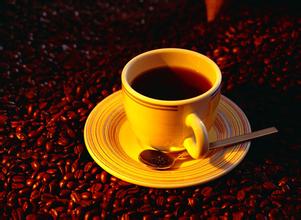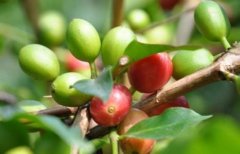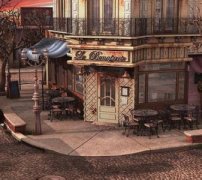The origin and development of Ecuadorian fine coffee with strong taste

Located in the south of the country's capital, SanJos é, Tarasu is one of the most valued coffee growers in the country. Tarasu Latin America (La Minita)
Tarrazu) coffee is a famous local product, but the production quantity is limited, about 72600 kilograms per year. It is a piece called "La".
Minita), which is owned by the last three generations of the McAlpine family in England. In fact, this land can produce more than 450 tons of coffee a year. But Tarasu Latin America coffee is grown without artificial fertilizers or insecticides, and its harvesting and selection are done by hand, in order to avoid some damage to coffee beans caused by air spray selection.
Other coffees worth mentioning are: Juan
Vinas,PR, H.Tournon, Windmill,SHB, Monte bello and Ssnta
Rosa). Fine coffee is generally grown in Geredia and the central canyon. Another striking coffee is Sarchi (one of the five towns representing Costa Rica's "Coffee Road"), which grows in the Boas volcano (Poas), 53 kilometers from San Jose
Volcano) on the hillside. Saatchi, founded in 1949, has a land area of 30770 hectares and grows sugar cane and coffee. The area is also famous for its handicrafts, attracting tourists from all over the world.
The country's coffee industry was originally owned by Costa Rica Coffee Industry Company (Instituto)
Controlled by del Caf é deCosta Rica, or ICAFE), and is now under the control of the official Coffee Committee (Oficinadel)
Caf é) take over. Among the exported coffee, those products that are considered to be of substandard quality are colored with blue vegetable dyes and then transferred back to China for sale. Coffee consumed domestically (dyed blue or undyed) accounts for about 10% of total production, and local per capita coffee consumption is twice that of Italy or the United States.
As the world dessert champion in 1995 and the European dessert champion in 2000, Mr. Marcolini's philosophy of success is absolute respect and dedication to ingredients. Ten years ago, he decided to be a great chocolate maker, searching for the best quality cocoa beans from all over the world, finding the roots of chocolate and releasing the true taste of chocolate. All the products sold in the Marcolini store, whether they are chocolate, almond cakes, jam and caramel, are made in the Marcolini workshop and taste pure and come from the original cocoa beans. The Marcolini brand has 14 kinds of cocoa beans from different regions, led by Ecuador, followed by the western coasts of Brazil and Cuba: including coastal plains and foothills, high in the east and low in the west, generally below 200m above sea level, and some hills and low mountains with an elevation of 600m to 700m. Belongs to the tropical rain forest climate, the southernmost end begins to transition to the savanna climate. The average annual precipitation decreases from more than 3000 mm to about 500mm from north to south.
Central mountain: after entering Ecuador from Colombia, the Andes is divided into the eastern and western Cordillera mountains, with a plateau high in the north and low in the south, averaging between 2500 and 3000 meters above sea level. The Andes run through the middle of the border. The ridges crisscross, dividing the plateau into more than ten intermountain basins. The most important are the Quito basin and the Cuenca basin in the south. There are many volcanoes and frequent earthquakes in the territory. The famous Kotopaxi volcano, 5897 meters above sea level, is one of the highest active volcanoes in the world. Chimborazo Mountain in central Ecuador, 6262 meters above sea level, is the highest peak in Ecuador, Mount Chimborazo in Ecuador. It is 6384.1 kilometers from the center of the earth to the top of the mountain. Mount Chimborazo, located in the West Cordillera in the Andes, has long been mistaken for the highest peak in the Andes. It is a dormant volcano with many craters and glaciers at the top of the mountain, about 4694 meters above, covered with snow all the year round.
Eastern region: part of the Amazon River basin. The foothills of the foothills with an altitude of 1200 to 250 meters above sea level are rapid. below 250 meters are alluvial plains. The river is open, the current is gentle, and there are many rivers.
Located in the Pacific Ocean, the Cologne Islands (Galapagos Islands) is more than 900km east from the continental coast and covers an area of 7800 square kilometers. it includes seven large islands and about 70 small islands, all composed of volcanic cones and lava.
The best Ecuadorian coffee is grown on St. Cristobal Island in the Galapagos Islands, which has the unique natural geographical conditions for giving birth to the best quality coffee in the world. A cup of Galapagos coffee, like the beautiful scenery of the Galapagos Islands, is sure to impress you.
In the mid-15th century, there were legends about enchanted mysterious islands among fishermen fishing in the western Pacific Ocean of South America. It is said that the islands can sometimes be seen clearly from a distance, but when the ship approaches, it disappears again; sometimes it looks like a galleon, sometimes it shows the shape of a witch. Fishermen call these islands "Devil Island", thinking that they may be ruled by demons like the sea banshees in the Odyssey. The island that fishermen call "Magic Island" is the Galapagos Islands today. When it comes to Ecuadorian coffee, we have to mention the organic coffee in the Galapagos Islands of Ecuador. The Galapagos Islands is a famous tourist attraction, declared as a "World Natural Heritage site" by the United Nations Educational, Scientific and Cultural Organization (UNESCO). It is extremely rich in products, and organic coffee is one of the unique ones. With its unique ecological environment such as fertile volcanic soil and microclimate, coupled with its cultivation without any chemical fertilizers and pesticides, organic coffee in the Galapagos Islands is recognized as a natural green boutique coffee. This naturally grown coffee has a mild taste, with a hint of grass, fruit and caramel, and is highly sought after by businessmen and coffee lovers. Mr. Diego Vega, Chief Commercial Officer of Ecuador's Export and Investment Promotion Agency, and CEO Erika Wang of the Research Institute attended the event and introduced Ecuador's diversified coffee producing areas to the public. Examples include Loja, Imbabura, Zamora, Vilcabamba and Galapagos.
Ecuador's unique ecosystem makes coffee from different coffee producing areas have a unique taste. That's why every mouthful of coffee made from Ecuadorian beans, whether single coffee or mixed coffee, is endless and tasteless.
The president is the chief executive of the country. The current Government was formed in April 2009 and has since been restructured several times to include 11 State Secretariats, 8 Coordination departments and 20 Executive departments. The current cabinet members are: Vinicio ALVARADO, Secretary of State for Public Administration; Fander FALCON í, Secretary of State for National Planning and Development; Fernando Alvarado, Secretary of State for Press; Lorena Escudero, Secretary of State for Immigration; and Mireya Cardenas, Secretary of State for nationalities, Social movements and Civic participation (Mireya C á Rdenas). Ren é RAMIREZ, Secretary of State for Science and Technology; Mar í a Cornejo, Secretary of State for risk Management; Diego Guzman, Secretary of State for Transparency; Pablo ROMERO, Secretary of State for Intelligence; Betty TOLA, Minister for political Coordination and Local self-Government; Jeannette S á NCHEZ, Minister for Economic Policy Coordination Minister of Security Coordination Homero Arellano (Homero ARELLANO), acting Minister of Strategic Industry Coordination Rahost l BONILLA, Minister of Social Development Coordination Doris Solis (Doris SOLIZ), acting Minister of Natural and Cultural Heritage Coordination Belan Moncayo, Minister of production, Employment and Competitiveness Coordination Santiago Leon, Minister of Talent Coordination Guillermo SOLORZANO Minister of the Interior Jos é SERRANO, Minister of Defense Mar í an Espinosa, Minister of Justice, Human Rights and Religion Johana PES á NTEZ, Minister of Finance Patricio Rivera (Patricio RIVERA), Minister of Foreign Affairs, Trade and Integration (Ricardo PATI?O), Minister of non-renewable Natural Resources Wilson Pastor (Wilson PASTOR) Power and Renewable Energy Minister Esteban Albornoz (Esteban ALBORNOZ), Minister of Transport and Public works Mar í a Duarte (Mar í a Duarte), Minister of Telecommunications and Information Society (Jaime RUIZ), Minister of Education Gloria Vidal (Gloria VIDAL), Minister of Labor Relations Richard Espinosa (Richard ESPINOSA), Minister of Economic and Social inclusion (Ximena PONCE) Kaarina Carina VANCE, Minister of Public Health, Pedro JARAMILLO, Minister of Urban Development and Housing, Erika SYLVA, Minister of Culture, Jose Cevallos, Minister of Sports, Lorena TAPIA, Minister of the Environment, Freddy EHLERS Ehlers, Minister of Tourism, Javier PONCE, Minister of Agriculture, Animal Husbandry, Aquaculture and Fisheries Ver ó nica SION, Minister of Industry
Miguel Monar, a famous Ecuadorian chef with more than 20 years of international experience in the catering industry, is committed to developing novel recipes that combine ingredients with Ecuadorian coffee-"spicy Mango Coffee Cocktail" is a creative drink that stimulates taste buds and gives you a different taste experience. High-quality Costa Rican coffee is called "hard beans". This kind of coffee can grow at an altitude of more than 1500 meters. Altitude has always been a problem for coffee growers. The higher the altitude, the better the coffee beans, not only because the higher altitude can increase the acidity of the coffee beans and thus increase the flavor, but also because the night temperature at the higher altitude is lower, which can make the trees grow slowly, thus making the coffee beans have a stronger flavor. In addition, due to the high altitude drop caused by sufficient rainfall, is also very beneficial to the growth of coffee trees. However, while there are many advantages to growing coffee at higher elevations, the resulting additional transport costs must be taken into account, which is likely to make coffee production unprofitable. The coffee industry in Costa Rica has adopted new technologies to increase efficiency, including the use of "electric eyes" to select beans and identify coffee beans of irregular size.
In Costa Rica, people unload coffee fruits from ox carts
Important Notice :
前街咖啡 FrontStreet Coffee has moved to new addredd:
FrontStreet Coffee Address: 315,Donghua East Road,GuangZhou
Tel:020 38364473
- Prev

A brief introduction to the description of taste and aroma characteristics of Ecuadorian boutique coffee with fresh and unique taste
Because of the unique role of the Galapagos Islands in the course of history, the Government of Ecuador has designated the Galapagos Islands as a national park, the land is no longer allowed to be reclaimed as new agricultural land, and the introduction and use of chemical fertilizers, pesticides, herbicides and other chemicals are strictly prohibited, so coffee produced in the Galapagos Islands is recognized as a natural product. Well-known brand in South America, Ecuador A
- Next

Taste balanced refreshing Ecuadorian fine coffee varieties cultivation market price profile
In 1535, Frei Thomas de Berlanga of Spain and others accidentally discovered the Galapagos Islands. Thomas was born in 1487 on the Duro River in the Spanish province of Soria. He was the fourth bishop of Panama at that time. He was ordered to go to Peru. When his ship set out from Panama on February 23, under the impact of a strong current, they were carried to an unknown sea in the outer ocean.
Related
- Detailed explanation of Jadeite planting Land in Panamanian Jadeite Manor introduction to the grading system of Jadeite competitive bidding, Red bid, Green bid and Rose Summer
- Story of Coffee planting in Brenka region of Costa Rica Stonehenge Manor anaerobic heavy honey treatment of flavor mouth
- What's on the barrel of Blue Mountain Coffee beans?
- Can American coffee also pull flowers? How to use hot American style to pull out a good-looking pattern?
- Can you make a cold extract with coffee beans? What is the right proportion for cold-extracted coffee formula?
- Indonesian PWN Gold Mandrine Coffee Origin Features Flavor How to Chong? Mandolin coffee is American.
- A brief introduction to the flavor characteristics of Brazilian yellow bourbon coffee beans
- What is the effect of different water quality on the flavor of cold-extracted coffee? What kind of water is best for brewing coffee?
- Why do you think of Rose Summer whenever you mention Panamanian coffee?
- Introduction to the characteristics of authentic blue mountain coffee bean producing areas? What is the CIB Coffee Authority in Jamaica?

